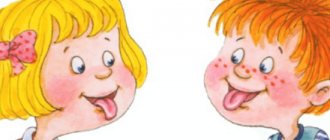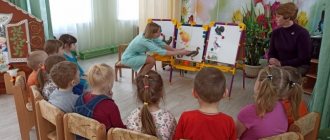Master classes for teachersconsultation on speech therapy
Master class for teachers
Fairytale therapy in working with preschool children
A fairy tale can provide clues to enter reality in new ways, it can help a child get to know the world, it can enrich his imagination and teach him to critically perceive his surroundings.
Gianni Rodari
The goal of fairy tale therapy is to activate the creative principle in a person, reveal the depths of his own inner world, and develop his self-awareness
Tasks:
- Create conditions for the development of creative imagination and originality of thinking.
- Stimulate creative self-expression.
- To form a positive attitude of the child towards his “I”.
Fairytale therapy means “treatment with a fairy tale.” As Vachkov I.V. writes, fairy tales are used by doctors, psychologists, and teachers, and every specialist finds in a fairy tale a resource that helps him solve his professional problems.
Fairytale therapy as a tool for transferring experience “from mouth to mouth.” This is a way of instilling in a child a special attitude towards the world, a way of conveying the necessary moral norms and rules. This information is contained in folk tales and legends, epics and parables.
Fairytale therapy as a development tool. In the process of listening, inventing and discussing a fairy tale, the child develops the skills of coherent speech, imagination, and creativity necessary for effective existence. He learns the basic mechanisms of search and decision-making.
Fairytale therapy as psychotherapy. Working with a fairy tale is aimed directly at treating and helping the client. The fairytale therapist creates conditions in which the client, working with a fairy tale (reading, inventing, acting out, continuing), finds solutions to his life difficulties and problems.
Within the framework of fairy tale therapy, there are five types of fairy tales:
We include fairy tales created by the centuries-old wisdom of the people and original stories as artistic fairy tales. Actually, this is what is usually called fairy tales, myths, parables, stories.
Folk tales carry extremely important ideas for us:
- The world around us is alive. Anything can speak to us at any moment. This idea is important for developing a caring and meaningful attitude towards what surrounds us. Starting from people, and ending with plants and man-made things.
- The revived objects of the surrounding world are capable of acting independently; they have the right to their own life. This idea is important for developing a feeling of acceptance of another.
- Separation of good and evil, victory of good. This idea is important for maintaining good spirits and developing aspirations for the best.
- The most valuable things are gained through testing, and what is given for nothing can quickly go away. This idea is important for the formation of the mechanism of goal setting and patience.
- There are many helpers around us. But they come to the rescue only if we cannot cope with the situation or task ourselves. This idea is important for developing a sense of independence, as well as trust in the world around us.
Author's artistic tales are more reverent and imaginative than folk ones.
Didactic fairy tales are created by teachers to “package” educational material. At the same time, abstract symbols (numbers, letters, sounds, arithmetic operations, etc.) are animated, creating a fabulous image of the world in which they live. Didactic tales can reveal the meaning and importance of certain knowledge. Educational tasks are presented in the form of didactic fairy tales.
Algorithm for a didactic fairy tale-task:
- Introduction to the fairy-tale land in which the animate symbol lives. A story about character, habits, life in this country.
- Destruction of well-being. Evil fairy-tale characters (dragon, Koschey), natural disasters (hurricane, rain), or a difficult emotional state (bored, sad, lack of friends) can act as a destroyer.
- Addressing a child. Only a person with an ardent heart and knowledge can save everything. Therefore, in order to restore the country, you need to complete a certain task.
Psychocorrectional fairy tales are created to have a gentle influence on the child’s behavior.
Psychotherapeutic tales. Fairy tales that heal the Soul... Fairy tales that reveal the deep meaning of current events. Psychotherapeutic tales often leave a person with a question. This, in turn, stimulates the process of personal growth.
Meditative tales are created to accumulate positive imaginative experience, relieve psycho-emotional stress, create better models of relationships in the soul, and develop personal resources. A distinctive feature of meditative fairy tales is the absence of conflicts and evil heroes.
The advantage of fairy tales for a child’s personality is as follows:
- Lack of didactics and moral teachings in fairy tales. The most that the fairy tale genre can “afford” is a hint on how best to act in a given life situation. In a fairy tale, no one teaches a child to “live correctly.” The events of a fairy tale flow naturally and logically from one another. Thus, the child perceives and assimilates the cause-and-effect relationships that exist in this world.
- Uncertainty of the location of the protagonist's action. “In some kingdom, in some state”... It’s as if they are making us understand that such a story could have happened anywhere: maybe far away, or maybe very close. This will depend on how closely you want to take the fairy tale story to yourself.
- Imagery of language. The main character in a fairy tale is a collective image. The names of the main characters are repeated from fairy tale to fairy tale: Ivanushka, Alyonushka, Marya. Fairy-tale stories encrypt situations and problems that every person experiences in his life. Life choices, love, responsibility, mutual assistance, overcoming oneself, the fight against evil - all this is “coded” in the images of a fairy tale.
- A treasure trove of wisdom. Each fairy-tale situation has many facets and meanings. A child, listening to a fairy tale, unconsciously draws out for himself the meaning that is most relevant to him at the moment. Over time, a person changes, and he can understand the same fairy tale in different ways... Children often ask their parents and educators to read the same fairy tale to them. Probably, this fairy tale most corresponds to the child’s worldview at the moment and helps him understand issues that are important to him. Thanks to the multifaceted meanings, the same fairy tale can help a child solve problems that are relevant to him at different periods of his life.
- Victory of Good. Psychological security. The hallmark of a true fairy tale is a good ending. This gives the child a feeling of psychological security. Whatever happens in the fairy tale, everything ends well. It turns out that all the trials that befell the heroes were needed in order to make them stronger and wiser. On the other hand, the child sees that the hero who committed a bad deed will definitely receive what he deserves. And the hero who goes through all the trials and shows his best qualities is sure to be rewarded. This is the law of life: how you relate to the World, so it treats you.
- The presence of Mystery and Magic. The aura of mystery and magic is a quality characteristic of fairy tales. A fairy tale is like a living organism - everything in it breathes, at any moment even a stone can come to life and speak. This feature of the fairy tale is very important for the development of the child’s psyche.
Fairytale therapy work with children is carried out
both individually and with a group:
- INDIVIDUAL WORK
The teacher is the main person; he actively participates in the process of fairy tale therapy, sets the topics for classes, and carefully observes the child’s behavior.
In order for a fairy tale to be interesting to a child and touch him, it is necessary to find out his interests and hobbies in a preliminary conversation, not so much to clarify the problem, but to identify positive aspects that can be relied on in the process of creating or selecting a story. Using a topic that is close and understandable to the child allows him to more easily get used to the image of a fairy-tale hero, relate him to his problems, and see the effectiveness of a way out of the current situation.
- WORK IN A GROUP
1) Listening to fairy tales and analysis (interpretation). The goal is awareness, interpretation of what is behind each fairy-tale situation, phrase, appearance of new characters, plot construction. It is not enough for a modern child to simply read a fairy tale, color its characters, and talk about the plot. With a child of the third millennium, it is necessary to comprehend fairy tales, together to search and find hidden meanings and life lessons. And in this case, fairy tales will never take the child away from reality. On the contrary, they will help him become an active creator in real life. But what is it like to comprehend fairy tales? How to find hidden life lessons in them? Let's try it together. Let's take, for example, the well-known fairy tale “Kolobok”. (Appendix. Analysis of the fairy tale “Kolobok”)
2) Group storytelling. In this case, the narrator is a group of children. Telling a fairy tale known to the whole group. Each participant takes turns telling a small piece of the story. The narrative is divided into fragments randomly, depending on which part of the story the previous narrator takes on. If storytelling is carried out in a children's group, the leader can participate in the storytelling.
3) Telling a famous fairy tale and inventing a sequel to it. After the tale is told, the group members come up with a continuation for it, and the last storyteller must finish the tale.
4) Group invention of a fairy tale. Someone begins to say the first phrase, for example: “In a certain kingdom, in a certain state...”. The next group member adds one or two phrases to the fairytale phrase, and so on.
5) Telling a fairy tale in the first person and on behalf of various characters in the fairy tale. Group members choose the tale they are going to tell and distribute the characters among themselves. In preschool age groups, it will be interesting to dramatize fairy tales.
6) Drawing a fairy tale. It is advisable to draw a fairy tale, mold it, or present it in the form of an applique. By drawing or working with colored cardboard or plasticine, the child embodies everything that worries him, feelings and thoughts. Thus, freeing yourself from anxiety or other feelings that bothered you.
To stimulate children's interest in literary creativity, the following techniques can be used:
1. Game “Twisting fairy tales”
“Rearranged on different rails,” a familiar fairy tale forces the child to relive it. In some cases, this game will have a healing effect: not be afraid of the wolf, etc. The second serious aspect of the game is that its participants must intuitively carry out a real analysis of the fairy tale.
2. Game “Inside-Out Fairy Tales”
One of the options for playing “twisting” fairy tales is to deliberately and more organically “turn inside out” the fairy tale theme. For example, a fairy tale in which Little Red Riding Hood is evil and the wolf is good.
3. Game “What happened then? »
Children are invited to listen to the teacher read a fairy tale and then all together come up with a continuation of the fairy tale.
4. Game “Salad from Fairy Tales”
Children, of course, with the help of a teacher, come up with a fairy tale in which the characters of many famous fairy tales interact.
5. Game “Make up a story”
The child is given the task to come up with a story about someone or something, spending just one minute on it, and then retell it within two minutes. This may not be a story, but, for example, some kind of story or fairy tale.
Fairytale therapy is perhaps the most children's method of psychology, and, of course, one of the most ancient. After all, even our ancestors, when raising children, were in no hurry to punish the guilty child, but told him a fairy tale, from which the meaning of the act became clear. I advise you to do this more often!!!
Practical part
Analysis of the fairy tale “KOLOBOK”
It is not enough for a modern child to simply read a fairy tale, color its characters, and talk about the plot. With a child of the third millennium, it is necessary to comprehend fairy tales, together to search and find hidden meanings and life lessons. And in this case, fairy tales will never take the child away from reality. On the contrary, they will help him become an active creator in real life.
But what is it like to comprehend fairy tales? How to find hidden life lessons in them? Let's try it together.
Let's take, for example, the well-known fairy tale “Kolobok”. We are sure that its contents are familiar to everyone, so we do not provide the text. We read a fairy tale with the child, but the fairytale therapy process has only just begun.
- Do you know that in a fairy tale, important messages are kept for us between the lines? A fairy tale wants to teach us about life, but so that it is not boring, it offers interesting stories. The story of Kolobok has many messages for us. Let us solve them for you.
- Do you remember how the fairy tale began? Once upon a time there lived a grandfather and a woman. They lived poorly and did not eat enough to eat. Grandfather asked grandma to bake a bun. It seemed like there was nothing to bake with, but I swept the barn with a broom, scraped the bottom of the tree, and found flour for the bun. What do you think the fairy tale wanted to tell us?
- Yes, it seems that the fairy tale teaches us to stock up. There are different situations in life, so it is customary to make preparations for future use. In the summer we go for berries, and grandma makes jam. We go for mushrooms, and then we salt them and dry them. Why do you think we plant potatoes in the spring and dig up potatoes in the fall? Of course, to have supplies. It is customary to make reserves in the animal world as well. Who is the most thrifty of the forest animals? And a squirrel and a hedgehog. So, the first fabulous lesson is - in order not to be hungry, store up for future use. Let's remember him.
- But what happened next in the fairy tale? Grandmother baked a bun, it turned out ruddy and beautiful. She put it on the window. Why did grandma put the bun on the window? After all, they wanted to eat so much, why did they hesitate? What does a fairy tale teach us?
- Could it be that too hot food is bad for us? Can you imagine what would have happened to grandfather if he had immediately put a hot piece of kolobok in his mouth? Of course, he would have burned his tongue, and for a long time afterwards he would not feel anything with it. Therefore, the second fabulous lesson is: don’t eat too hot, don’t rush, even when you really want to try.
- And then our bun came to life in a fairy tale! He jumped from the window and rolled along the forest path. What is hidden behind this event? Maybe some advice not to leave the bun unattended? The gingerbread man came to life, got bored alone and rolled along the path. Who can behave like this? Of course, child! It seems that the fairy tale hints at a child’s character - it’s so boring to be alone, and I really want to learn something new, go somewhere alone, without dad, without mom, to show everyone how grown-up and independent I am! Do you ever have such a desire? Of course, that’s why it’s not difficult for you to understand Kolobok. Probably, the third fairy tale lesson is needed more by adults. The fairy tale teaches, on the one hand, not to leave children unattended. On the other hand, the fairy tale seems to ask adults to remember themselves as small: when they so wanted to seem big and independent. When we pulled our palm out of my mother’s hands and said: “I myself!” Maybe the third fairytale lesson is that we, adults, do not forget childhood?..
-Who does Kolobok meet on the forest path? First a hare, then a wolf and a bear. They all immediately want to eat him, and he sings his song to them: “I left my grandmother, I left my grandfather...” What does the fairy tale teach us? Of course, first of all, don’t get scared right away if someone threatens you. There are different people in life: some are friendly, but some are dangerous. And if fate brings you together with a dangerous animal or person, this means that a situation has arisen that requires you to “overcome a difficulty.”
- Let's remember how fairy tales teach us to overcome difficulties. It happens that you need to immediately hit back at the offender. In fairy tales, the hero draws his sharp sword and strikes. This is a good way, but it doesn't always work. What does it take to hit back at the offender? At the very least, you need to have enough strength, then you need a wonderful sword. Did Kolobok have all this? Could he compete in strength with a hare, a wolf, and even more so, with a bear? Of course not! Therefore, this method of overcoming the difficulty would not lead to anything good.
— What other ways are there to overcome difficulties in fairy tales? Yes, you can call your friends for help. But did Kolobok have friends? Nothing is known about this in the fairy tale. In addition, while Kolobok was calling for help, even a fast hare would have time to grab him and eat him. It seems that this method is also not suitable for Kolobok’s situation.
— There is also a wonderful way to overcome difficulties - cunning. Do you remember Puss in Boots? As he cleverly said to the cannibal: “I will never believe that you can turn into a little mouse!” The giant was caught. Could Kolobok have used a trick? What would it look like? For example, having met a hare, Kolobok tells him: “Hare, hare, everyone says about you that you run the fastest in the forest. But I don’t believe it. That's right, it's hard for you to run to the edge and back while I take three breaths in and out! Yes, you’re probably not that fast if you’re so hungry that you want to eat me.” Maybe Kolobok would be able to outwit the hare, or maybe not.
— What method of overcoming difficulties does Kolobok choose in the fairy tale? Yes, he sings a song and runs away. There are situations when it is best to run away from danger.
- But what is he singing about? “I left my grandmother, I left my grandfather, I left the hare, and I’ll leave you, the wolf, even more so...” What does Kolobok do when he sings a song? Of course he brags and then runs away.
— What is the fourth fairy tale lesson? Kolobok teaches us not to get lost in a difficult situation, not to be scared, but to come up with a way to cope with the difficulty.
“You and I understand that in his song Kolobok is bragging.” And further from the fairy tale we will learn what this led to. The sly fox ate Kolobok. Let's think about what a fairy tale can teach us in this situation.
- Of course, boastful songs, even if they helped out before, will not lead to any good. There is always someone who will listen to boastful songs, waiting for an opportunity. The braggart will relax and feel that nothing threatens him. It is at this moment that trouble comes. Therefore, the fifth fairy tale lesson may sound like this: when you are in the forest, finding yourself in a difficult situation, be on alert: dangerous people or animals do not always directly communicate their intentions (“I will eat you”), it happens that they hide their true desire by saying sweet affectionate speeches. And we must be very careful in order to unravel the plans of people like the fox in time. This is a very important life lesson. Both children and adults need it.
- The fairy tale is over. Do you think the fairy tale has a good ending or not? Do you think this fairy tale has a bad ending because the fox ate Kolobok? Let’s think about what would have happened if Kolobok had rolled away from the fox.
“He would ride around the forest for a week or two.” I rolled home to my grandparents. And then - they began to live well and make good things? Is this ending good? Do you remember why your grandfather asked you to bake a bun? Yes, he was hungry. Now imagine what grandfather would immediately do if he saw a bun? I probably would have eaten it. Now imagine: the bun traveled through the forest for a week, in what condition would it roll home, how tasty would it be? Agree, eating a stale and dirty bun is not very pleasant. But, “hunger is not a problem.” Therefore, most likely, the bun was actually eaten.
- And, actually, what was it baked for? To satisfy hunger, to bring joy. The fox was just luckier.
- What is the sixth fairy tale lesson? The fairy tale teaches that each of us has our own destiny. What it is? Each of us has abilities and talents. When we grow up, we choose a profession and go to work. We choose a profession and a job for a reason. We choose them according to their purpose. We know that it is in this work that we will bring the most benefit to ourselves, our loved ones and other people. And if a person has done a lot for others, they say about him: “He fulfilled his destiny.”
- Do you see what important things can be learned from a simple fairy tale? How much life advice you and I received. Are you interested in solving fairy tale lessons? Then choose the next fairy tale...
Welcome to the Training Center “Speech Therapist Master”
Our project was created for those who are looking for professional retraining, advanced training courses, seminars and webinars for speech therapists and defectologists. For those who want to learn from masters of their craft. For those who want to study in comfort. For those who value their time. The Speech Pathologist Master training center guarantees you all this!
Professional retraining programs are being implemented at our training center. For each program we offer 2 forms of training. You can study at our center or from home. Teachers of the retraining program are experts in their field and will share not only theoretical knowledge, but also introduce you to the practical aspects of the work!
We broadcast our seminars online via webinars. For the convenience of listeners who are in a different time zone, we sell educational films with recordings of our most popular seminars.
Our advanced training courses will satisfy the most demanding students. Over the 15 years of our center’s existence, we have trained more than 6,000 students. The most popular topics: speech therapy and probe massage, neuropsychology, correction of sound pronunciation, treatment of stuttering, logorhythmics, reading and writing disorders, speech therapy examination, work with young children, myofunctional correction. All our courses are conducted in accordance with the requirements of the Federal State Educational Standard. If you are a speech pathologist, training at our center will help you improve your skills.
It is possible to take courses remotely. We conduct advanced training courses and on-site seminars in all cities of Russia. Based on the results of your training, you receive state-issued documents. License No. 040072 dated May 17, 2019
We have a store called Everything for a Speech Pathologist, where you can choose any products for the work of a speech therapist, speech pathologist, or psychologist. We deliver store goods throughout Russia and to countries near and far abroad.
Experienced speech-language pathologists work with all types of speech pathology. On-the-job training was organized.
If you need to hold a seminar, master class, presentation, training, individual consultation, we will be happy to rent out our hall for an hour, a day, according to your schedule. It is possible to broadcast your event online anywhere in the world. We will help with organizing coffee breaks and video shooting.







